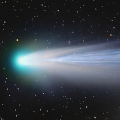
|
Now it is 4.0 mag (Nov. 1, Yoshimi Nagai). It will fade out rapidly after this. In the Northern Hemisphere, it will be unobservable soon. In the Southern Hemisphere, it is not observable now, but it will appear in December.
Date(TT) R.A. (2000) Decl. Delta r Elong. m1 Best Time(A, h)
Nov. 1 16 23.58 2 47.6 0.778 0.559 34 3.9 20:02 ( 89, -5)
Nov. 8 16 54.47 -8 52.3 1.006 0.530 30 4.3 20:12 ( 78, 0)
|
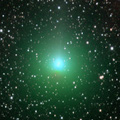
|
It brightened up to 5.2 mag in October (Oct. 11, Virgilio Gonano). Now it is 8.0 mag (Nov. 2, Virgilio Gonano). Fading rapidly. It stays observable in good condition.
Date(TT) R.A. (2000) Decl. Delta r Elong. m1 Best Time(A, h)
Nov. 1 21 53.42 -1 36.7 0.365 1.174 111 7.7 20:02 (159, 54)
Nov. 8 22 46.79 2 21.0 0.484 1.291 118 8.8 20:12 (167, 52)
|

|
Brightened rapidly. It is expected to brighten up to 8 mag from late autumn to early winter. Now it is 11.7 mag (Oct. 30, Martin Masek). It brightens up to 8.5 mag, but it will turn to fade out rapidly after that. In the Northern Hemisphere, it is not observable now, but it will be observable soon. In the Southern Hemisphere, it will be unobservable soon. But it will be observable again in December. It is fainter than this ephemeris recently.
Date(TT) R.A. (2000) Decl. Delta r Elong. m1 Best Time(A, h)
Nov. 1 16 37.77 -37 53.4 0.448 0.695 37 9.9 20:02 ( 57, 19)
Nov. 8 15 51.14 -33 14.3 0.430 0.611 21 9.0 20:12 ( 50, 2)
|
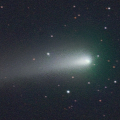
|
Now it is 9.3 mag (Nov. 2, Virgilio Gonano). Fading rapidly. It will be fainter than 18 mag in February. In the Northern Hemisphere, it stays observable in good condition. In the Southern Hemisphere, it will be unobservable soon.
Date(TT) R.A. (2000) Decl. Delta r Elong. m1 Best Time(A, h)
Nov. 1 11 38.34 4 52.4 0.825 0.718 45 9.8 3:25 (263, 3)
Nov. 8 11 27.07 14 16.2 0.655 0.864 59 10.1 3:16 (251, 3)
|
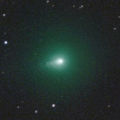
|
Third interstellar object in history following 1I/'Oumuamua and 2I/Borisov. The eccentricity is extremely big as 6. It approached to Sun down to 1.38 a.u. in late October. Now it is 9.6 mag (Nov. 3, Ken-ichi Kadota). It will fade out rapidly after this. It will be fainter than 18 mag in February. In the Northern Hemisphere, it will be getting higher gradually. In the Southern Hemisphere, it is not observable now, but it will be observable soon.
Date(TT) R.A. (2000) Decl. Delta r Elong. m1 Best Time(A, h)
Nov. 1 13 24.25 -6 31.9 2.280 1.360 16 10.5 3:25 (287,-12)
Nov. 8 13 8.38 -5 15.8 2.199 1.400 27 10.6 3:16 (281, -6)
|
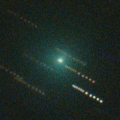
|
Bright new comet. Now it is 10.4 mag (Nov. 2, Osamu Miyazaki). It brightens up to 10 mag, but it will turn to fade out rapidly after that. In the Northern Hemisphere, it will be unobservable in January. In the Southern Hemisphere, it is not observable now.
Date(TT) R.A. (2000) Decl. Delta r Elong. m1 Best Time(A, h)
Nov. 1 14 15.90 55 14.9 1.135 1.220 69 11.0 3:25 (224,-46)
Nov. 8 15 49.17 52 48.5 1.050 1.177 70 10.5 20:12 (132,-40)
|
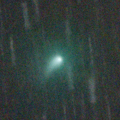
|
It is expected to brighten up to 5 mag in January. Now it is 12.6 mag (Oct. 21, Taras Prystavski). It will brighten rapidly after this. In the Northern Hemisphere, it will be unobservable in December. But it will be observable again in February. In the Southern Hemisphere, it is not observable now, but it will appear in January.
Date(TT) R.A. (2000) Decl. Delta r Elong. m1 Best Time(A, h)
Nov. 1 16 47.53 8 12.1 2.271 1.672 42 11.0 20:02 ( 97, -4)
Nov. 8 16 58.11 4 45.2 2.225 1.564 37 10.7 20:12 ( 90, -7)
|
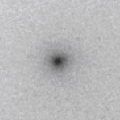
|
Bright new comet. Now it is 10.9 mag (Nov. 4, Martin Masek). It brightens up to 10.5 mag, but it will turn to fade out rapidly after that. It will be fainter than 18 mag in January. In the Northern Hemisphere, it will be unobservable soon. It stays extremely low in the Southern Hemisphere.
Date(TT) R.A. (2000) Decl. Delta r Elong. m1 Best Time(A, h)
Nov. 1 11 56.24 -6 36.7 0.842 0.602 37 11.9 3:25 (274, 6)
Nov. 8 13 15.37 0 40.5 0.708 0.510 29 10.8 3:16 (277,-10)
|
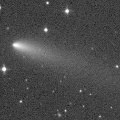
|
Now it is brighter than originally expected. Now it is 12.5 mag (Nov. 1, Osamu Miyazaki). Fading slowly. It stays observable in good condition. It is expected to brighten up to 12 mag and to be observable in good condition from autumn to winter. A 19-mag fragment was found on Oct. 3.
Date(TT) R.A. (2000) Decl. Delta r Elong. m1 Best Time(A, h)
Nov. 1 4 7.89 2 23.4 1.230 2.157 151 12.3 1:28 (180, 53)
Nov. 8 4 2.16 3 26.0 1.195 2.147 158 12.2 0:55 (180, 52)
|
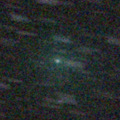
|
It will brighten up to 8 mag in winter, and will be observable in good condition. Now it is 16.2 mag (Oct. 22, Hiroshi Abe). Brightening rapidly. In the Northern Hemisphere, it stays observable in good condition. It locates somewhat low in the Southern Hemisphere. But it will become high in winter.
Date(TT) R.A. (2000) Decl. Delta r Elong. m1 Best Time(A, h)
Nov. 1 8 8.19 20 9.8 0.955 1.477 98 13.5 3:25 (213, 28)
Nov. 8 8 35.20 20 12.8 0.877 1.427 99 12.7 3:16 (215, 27)
|
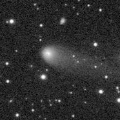
|
Now it is 13.4 mag (Oct. 29, Osamu Miyazaki). Fading slowly. In the Northern Hemisphere, it stays observable in good condition. It locates somewhat low in the Southern Hemisphere.
Date(TT) R.A. (2000) Decl. Delta r Elong. m1 Best Time(A, h)
Nov. 1 3 29.86 26 28.1 2.961 3.910 160 13.3 0:50 (180, 28)
Nov. 8 3 26.98 26 20.8 2.951 3.924 167 13.3 0:20 (180, 29)
|
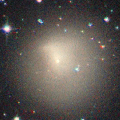
|
Now it is 15.7 mag (Oct. 28, Francois Kugel). In the Northern Hemisphere, it stays observable in good condition. In the Southern Hemisphere, it will be getting higher gradually.
Date(TT) R.A. (2000) Decl. Delta r Elong. m1 Best Time(A, h)
Nov. 1 11 15.83 -0 0.3 6.910 6.300 48 14.2 3:25 (263, 10)
Nov. 8 11 19.34 -0 30.1 6.820 6.301 54 14.2 3:16 (261, 14)
|

|
Now it is 17.7 mag (July 24, Thomas Lehmann). It will brighten rapidly after this. Now it is not observable. It will appear in January in the Southern Hemisphere, or in December in the Northern Hemisphere.
Date(TT) R.A. (2000) Decl. Delta r Elong. m1 Best Time(A, h)
Nov. 1 14 6.34 -11 26.3 2.951 1.965 5 14.5 3:25 (298,-17)
Nov. 8 14 22.29 -12 56.5 2.895 1.919 8 14.2 3:16 (298,-15)
|

|
It is expected to brighten up to 13 mag in early summer in 2026. Now it is 14.8 mag (Oct. 10, J. Tapioles). It stays 14 mag for a while. In the Northern Hemisphere, it will be unobservable temporarily in January. In the Southern Hemisphere, it will be unobservable in December. But it will be observable again in February.
Date(TT) R.A. (2000) Decl. Delta r Elong. m1 Best Time(A, h)
Nov. 1 19 14.72 4 59.7 4.009 3.864 74 14.4 20:02 (118, 26)
Nov. 8 19 13.34 3 48.6 4.107 3.841 67 14.4 20:12 (110, 20)
|
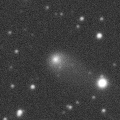
|
Now it is 14.9 mag (Oct. 17, Ken-ichi Kadota). It stays 14 mag for a while. In the Northern Hemisphere, it stays observable in good condition. It locates somewhat low in the Southern Hemisphere.
Date(TT) R.A. (2000) Decl. Delta r Elong. m1 Best Time(A, h)
Nov. 1 9 14.85 19 43.6 5.514 5.489 83 14.6 3:25 (227, 19)
Nov. 8 9 18.21 20 2.0 5.408 5.492 89 14.6 3:16 (224, 21)
|

|
Now it is 14.4 mag (Oct. 11, Hiroshi Abe). It stays 15 mag for a while. In the Northern Hemisphere, it will be unobservable soon. But it will be observable again in December. In the Southern Hemisphere, it is not observable now, but it will appear in January.
Date(TT) R.A. (2000) Decl. Delta r Elong. m1 Best Time(A, h)
Nov. 1 16 1.10 -1 16.3 6.771 5.906 27 14.6 20:02 ( 83, -8)
Nov. 8 16 6.72 -1 15.4 6.826 5.934 23 14.6 20:12 ( 78,-15)
|

|
It will brighten up to 13 mag in 2026. Now it is 15.3 mag (Oct. 21, ATLAS-HKO, Haleakala). It stays 15 mag for a while. It will be unobservable in December. But it will be observable again in January in the Northern Hemisphere, or in February in the Southern Hemisphere.
Date(TT) R.A. (2000) Decl. Delta r Elong. m1 Best Time(A, h)
Nov. 1 18 38.06 -9 24.2 5.482 5.094 62 15.0 20:02 ( 99, 28)
Nov. 8 18 41.03 -8 56.7 5.541 5.057 56 15.0 20:12 ( 94, 21)
|
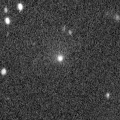
|
Very large comet. It is expected to brighten up to 13 mag in 2031. Now it is 15.5 mag (Oct. 26, Andrew Pearce). It stays 15 mag for a while. In the Northern Hemisphere, it is not observable now. In the Southern Hemisphere, it stays observable in good condition. In the Northern Hemisphere, it is not observable until 2030.
Date(TT) R.A. (2000) Decl. Delta r Elong. m1 Best Time(A, h)
Nov. 1 5 38.29 -73 37.7 14.614 14.592 86 15.0 2:56 ( 0, 51)
Nov. 8 5 35.37 -73 59.2 14.607 14.569 85 15.0 2:26 ( 0, 51)
|

|
Now it is 16.9 mag (Oct. 22, Hiroshi Abe). It stays 15 mag for a while. In the Northern Hemisphere, it stays observable in good condition. In the Southern Hemisphere, it will be getting higher gradually. It is fainter than this ephemeris recently.
Date(TT) R.A. (2000) Decl. Delta r Elong. m1 Best Time(A, h)
Nov. 1 10 16.18 2 16.2 2.804 2.525 63 15.0 3:25 (252, 21)
Nov. 8 10 25.50 1 0.1 2.738 2.538 67 15.0 3:16 (251, 23)
|

|
It is expected to brighten up to 13.5 mag and to be observable in good condition in 2026 spring. Now it is 16.8 mag (Aug. 12, ATLAS South Africa). Brightening slowly. In the Northern Hemisphere, it is not observable now, but it will appear in December. It stays extremely low in the Southern Hemisphere. But it will become high in winter.
Date(TT) R.A. (2000) Decl. Delta r Elong. m1 Best Time(A, h)
Nov. 1 14 22.75 -52 56.5 2.605 1.932 38 15.4 3:25 (330, 10)
Nov. 8 14 35.78 -51 2.8 2.617 1.889 34 15.4 3:16 (328, 10)
|
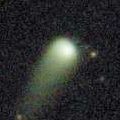
|
It was observed at 12-13 mag for a long time in 2024. Now it is 14.9 mag (Oct. 27, W. Pei). Fading slowly. In the Northern Hemisphere, it stays observable in good condition. In the Southern Hemisphere, it will be unobservable in December.
Date(TT) R.A. (2000) Decl. Delta r Elong. m1 Best Time(A, h)
Nov. 1 22 42.35 45 7.4 4.504 5.129 124 15.4 20:02 (179, 10)
Nov. 8 22 36.86 43 12.8 4.599 5.169 120 15.4 20:12 (171, 11)
|

|
Now it is 15.0 mag (Oct. 28, ATLAS Chile). It stays 15 mag for a while. It stays extremely low in the Northern Hemisphere. But it will become high in autumn. In the Southern Hemisphere, it stays observable in good condition. It is expected to brighten up to 12 mag in winter between 2026 and 2027.
Date(TT) R.A. (2000) Decl. Delta r Elong. m1 Best Time(A, h)
Nov. 1 3 5.31 -46 7.2 5.464 6.006 118 15.4 0:25 ( 0, 79)
Nov. 8 3 0.94 -46 4.8 5.443 5.964 117 15.4 23:49 ( 0, 79)
|

|
It will brighten up to 12 mag in 2026 summer. Now it is 16.4 mag (Oct. 13, Francois Kugel). Brightening slowly. It will be getting lower gradually after this, and it will be unobservable in January in the Southern Hemisphere, or in February in the Northern Hemisphere.
Date(TT) R.A. (2000) Decl. Delta r Elong. m1 Best Time(A, h)
Nov. 1 20 12.58 -13 52.6 2.628 2.708 83 15.8 20:02 (112, 50)
Nov. 8 20 19.77 -13 45.6 2.690 2.676 78 15.7 20:12 (106, 44)
|
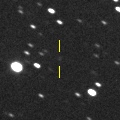
|
Now it is 14.3 mag (Oct. 17, X. Gao, X. Liao). It stays 15 mag for a while. It locates somewhat low. But it will become high in winter in the Southern Hemisphere, or in spring in the Northern Hemisphere.
Date(TT) R.A. (2000) Decl. Delta r Elong. m1 Best Time(A, h)
Nov. 1 12 17.84 -5 42.7 2.789 2.020 32 15.9 3:25 (276, 1)
Nov. 8 12 33.46 -7 5.5 2.737 2.010 35 15.8 3:16 (277, 2)
|
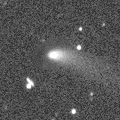
|
Now it is 15.6 mag (Oct. 27, Masayoshi Yoshimi). Fading slowly. In the Northern Hemisphere, it stays observable in good condition. In the Southern Hemisphere, it will be getting lower gradually after this, and it will be unobservable in February.
Date(TT) R.A. (2000) Decl. Delta r Elong. m1 Best Time(A, h)
Nov. 1 22 38.54 -8 55.8 2.184 2.808 119 16.2 20:02 (176, 64)
Nov. 8 22 40.18 -8 14.8 2.269 2.808 112 16.3 20:12 (158, 61)
|

|
Now it is 16.4 mag (Oct. 22, Hiroshi Abe). It stays 16 mag for a while. In the Northern Hemisphere, it stays observable in good condition. In the Southern Hemisphere, it will be unobservable in December.
Date(TT) R.A. (2000) Decl. Delta r Elong. m1 Best Time(A, h)
Nov. 1 8 54.47 37 7.6 3.893 4.063 92 16.2 3:25 (213, 8)
Nov. 8 8 55.74 38 58.0 3.799 4.082 99 16.2 3:16 (209, 8)
|

|
Now it is 16.3 mag (Oct. 7, ATLAS-MLO, Mauna Loa). It stays 16 mag for a while. It stays observable in good condition.
Date(TT) R.A. (2000) Decl. Delta r Elong. m1 Best Time(A, h)
Nov. 1 8 54.62 -11 45.0 6.682 6.581 79 16.3 3:25 (249, 45)
Nov. 8 8 56.32 -11 53.8 6.585 6.584 85 16.3 3:16 (246, 49)
|

|
It brightened up to 12.7 mag in 2024 summer (Aug. 7, 2024, Thomas Lehmann). Now it is 15.5 mag (Oct. 17, D. Buczynski). Fading slowly. In the Northern Hemisphere, it stays observable in good condition. It stays extremely low in the Southern Hemisphere.
Date(TT) R.A. (2000) Decl. Delta r Elong. m1 Best Time(A, h)
Nov. 1 22 16.70 54 33.6 3.786 4.338 117 16.3 20:02 (176, 0)
Nov. 8 22 17.12 53 39.3 3.871 4.393 115 16.4 20:12 (170, 0)
|
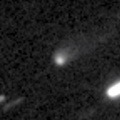
|
Now it is 16.2 mag (Oct. 27, J. Tapioles). It stays 17 mag for a while. It will be unobservable in January.
Date(TT) R.A. (2000) Decl. Delta r Elong. m1 Best Time(A, h)
Nov. 1 19 18.03 -29 56.6 3.219 3.005 68 16.3 20:02 ( 82, 47)
Nov. 8 19 28.00 -29 31.5 3.313 3.013 63 16.4 20:12 ( 79, 41)
|
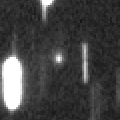
|
Now it is 17.4 mag (Oct. 16, Francois Kugel). It stays 17 mag for a while. In the Northern Hemisphere, it stays observable in good condition. In the Southern Hemisphere, it will be getting lower gradually after this, and it will be unobservable in February.
Date(TT) R.A. (2000) Decl. Delta r Elong. m1 Best Time(A, h)
Nov. 1 20 30.94 -14 0.4 1.841 2.062 88 16.5 20:02 (117, 53)
Nov. 8 20 42.03 -13 16.2 1.904 2.051 83 16.4 20:12 (111, 48)
|

|
Now it is 17.1 mag (Oct. 26, C. Demeautis). It stays 17 mag for a while. It locates somewhat low in the Northern Hemisphere. But it will become high in winter. In the Southern Hemisphere, it will never be observable after this.
Date(TT) R.A. (2000) Decl. Delta r Elong. m1 Best Time(A, h)
Nov. 1 15 11.02 63 26.4 4.526 4.432 78 16.5 20:02 (147,-41)
Nov. 8 15 32.81 63 27.2 4.504 4.446 80 16.6 20:12 (147,-43)
|

|
Now it is 17.3 mag (Oct. 17, Ken-ichi Kadota). It stays 17 mag for a while. In the Northern Hemisphere, it stays observable in good condition. It stays extremely low in the Southern Hemisphere.
Date(TT) R.A. (2000) Decl. Delta r Elong. m1 Best Time(A, h)
Nov. 1 5 14.52 51 28.4 3.139 3.849 129 16.8 2:35 (180, 4)
Nov. 8 5 11.62 52 11.4 3.080 3.845 134 16.7 2:05 (180, 3)
|
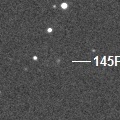
|
Now it is 16.8 mag (Oct. 25, Andrew Pearce). It stays 17 mag for a while. In the Northern Hemisphere, it stays observable in good condition. In the Southern Hemisphere, it will be getting lower gradually.
Date(TT) R.A. (2000) Decl. Delta r Elong. m1 Best Time(A, h)
Nov. 1 22 21.15 -18 45.6 1.483 2.066 111 16.8 20:02 (161, 73)
Nov. 8 22 25.51 -17 18.1 1.530 2.042 106 16.8 20:12 (141, 68)
|
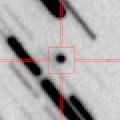
|
Now it is 17.2 mag (Oct. 23, Ken-ichi Kadota). It stays 17 mag for a while. In the Northern Hemisphere, it stays observable in good condition. In the Southern Hemisphere, it will be getting higher gradually.
Date(TT) R.A. (2000) Decl. Delta r Elong. m1 Best Time(A, h)
Nov. 1 3 49.32 33 55.6 1.588 2.511 152 17.0 1:10 (180, 21)
Nov. 8 3 33.78 29 46.9 1.502 2.469 163 16.8 0:27 (180, 25)
|
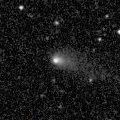
|
It brightened very rapidly, and it became brighter than expected. Now it is 16.3 mag (Oct. 12, Andrew Pearce). Fading slowly. It will be fainter than 18 mag in January. It stays observable in good condition.
Date(TT) R.A. (2000) Decl. Delta r Elong. m1 Best Time(A, h)
Nov. 1 0 20.76 -5 58.7 2.607 3.454 143 16.8 21:37 (180, 61)
Nov. 8 0 18.81 -6 2.2 2.682 3.463 135 16.9 21:08 (180, 61)
|

|
It brightened up to 12.1 mag in early summer (June 10, Taras Prystavski). Now it is 17.0 mag (Oct. 20, ATLAS-TDO). Fading slowly. It will be fainter than 18 mag in January. In the Northern Hemisphere, it stays observable in good condition.
Date(TT) R.A. (2000) Decl. Delta r Elong. m1 Best Time(A, h)
Nov. 1 9 4.56 12 31.6 2.102 2.222 83 16.9 3:25 (230, 26)
Nov. 8 9 10.05 12 25.2 2.065 2.279 89 17.0 3:16 (227, 28)
|

|
Now it is 16.9 mag (Oct. 3, ATLAS-MLO, Mauna Loa). It stays 17 mag for a while. In the Northern Hemisphere, it stays observable in good condition. In the Southern Hemisphere, it will never be observable after this.
Date(TT) R.A. (2000) Decl. Delta r Elong. m1 Best Time(A, h)
Nov. 1 9 40.61 81 37.1 4.817 5.108 101 16.9 3:25 (188,-30)
Nov. 8 10 17.59 82 57.6 4.775 5.103 103 16.9 3:16 (187,-31)
|

|
Now it is 16.9 mag (July 13, Taras Prystavski). It stays 17 mag for a while. It locates somewhat low in the Northern Hemisphere. But it will become high in spring. In the Southern Hemisphere, it will be getting higher gradually.
Date(TT) R.A. (2000) Decl. Delta r Elong. m1 Best Time(A, h)
Nov. 1 11 3.10 -23 20.4 6.189 5.577 48 16.9 3:25 (282, 25)
Nov. 8 11 3.20 -23 36.7 6.123 5.596 53 16.9 3:16 (280, 29)
|
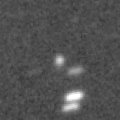
|
Brightening rapidly. It is expected to brighten up to 13 mag from 2027 to 2028. Now it is 16.8 mag (Oct. 17, Ken-ichi Kadota). It stays 17 mag for a while. In the Northern Hemisphere, it stays observable in good condition. In the Southern Hemisphere, it will be unobservable in December.
Date(TT) R.A. (2000) Decl. Delta r Elong. m1 Best Time(A, h)
Nov. 1 21 32.24 22 8.7 6.744 7.157 110 17.0 20:02 (160, 30)
Nov. 8 21 30.48 21 50.9 6.801 7.118 104 16.9 20:12 (151, 27)
|

|
Now it is 16.9 mag (Oct. 13, Ken-ichi Kadota). It stays 17 mag for a while. In the Northern Hemisphere, it stays observable in good condition. It locates somewhat low in the Southern Hemisphere.
Date(TT) R.A. (2000) Decl. Delta r Elong. m1 Best Time(A, h)
Nov. 1 10 24.41 20 0.1 2.390 2.222 68 17.0 3:25 (239, 8)
Nov. 8 10 35.33 19 50.3 2.348 2.261 72 17.0 3:16 (238, 9)
|
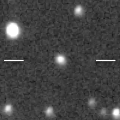
|
Although it is around 20 mag usually, now it is bright in outburst. Now it is 17.1 mag (Oct. 13, Ken-ichi Kadota). It stays 17 mag for a while. In the Northern Hemisphere, it stays observable in good condition. It stays extremely low in the Southern Hemisphere.
Date(TT) R.A. (2000) Decl. Delta r Elong. m1 Best Time(A, h)
Nov. 1 3 2.45 38 31.3 7.954 8.860 154 17.0 0:23 (180, 16)
Nov. 8 2 59.65 38 27.5 7.924 8.850 157 17.0 23:48 (180, 16)
|

|
Now it is 17.3 mag (Oct. 13, Ken-ichi Kadota). It stays 17 mag for a while. In the Northern Hemisphere, it stays observable in good condition. In the Southern Hemisphere, it is not observable now.
Date(TT) R.A. (2000) Decl. Delta r Elong. m1 Best Time(A, h)
Nov. 1 11 19.12 71 10.0 3.960 4.100 91 17.1 3:25 (201,-29)
Nov. 8 11 18.18 71 59.7 3.857 4.071 95 17.0 3:16 (200,-28)
|
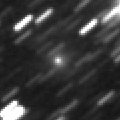
|
Very far object. Now it is 16.6 mag (Oct. 19, ATLAS Chile). It stays 17 mag for a while. In the Northern Hemisphere, it is not observable now, but it will appear in December. In the Southern Hemisphere, it stays observable in good condition.
Date(TT) R.A. (2000) Decl. Delta r Elong. m1 Best Time(A, h)
Nov. 1 0 23.84 -56 32.3 10.700 10.995 104 17.1 21:40 ( 0, 69)
Nov. 8 0 19.63 -56 4.1 10.781 11.008 100 17.1 21:08 ( 0, 69)
|
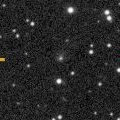
|
Now it is 18.0 mag (Oct. 25, ATLAS-MLO, Mauna Loa). It stays 17 mag for a while. It locates somewhat low in the Northern Hemisphere. In the Southern Hemisphere, it stays observable in good condition.
Date(TT) R.A. (2000) Decl. Delta r Elong. m1 Best Time(A, h)
Nov. 1 9 41.29 -21 47.0 4.749 4.458 67 17.1 3:25 (269, 41)
Nov. 8 9 45.50 -22 59.6 4.673 4.461 71 17.1 3:16 (269, 45)
|

|
Now it is 17.1 mag (Oct. 17, Ken-ichi Kadota). Fading slowly. It will be fainter than 18 mag in December. In the Northern Hemisphere, it will be getting lower gradually. In the Southern Hemisphere, it will never be observable after this.
Date(TT) R.A. (2000) Decl. Delta r Elong. m1 Best Time(A, h)
Nov. 1 18 40.63 58 24.8 1.740 1.994 89 17.2 20:02 (151,-16)
Nov. 8 18 40.99 52 21.6 1.813 1.984 84 17.3 20:12 (143,-16)
|
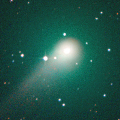
|
It was observed at 9-10 mag for a long time in 2023. It is fading very slowly. Now it is 16.9 mag (Sept. 29, ATLAS South Africa). It stays 18 mag for a while. In the Northern Hemisphere, it will never be observable after this. In the Southern Hemisphere, it will be getting lower gradually. But it will be getting higher again after January.
Date(TT) R.A. (2000) Decl. Delta r Elong. m1 Best Time(A, h)
Nov. 1 18 55.69 -68 6.6 8.949 8.636 68 17.2 20:02 ( 26, 44)
Nov. 8 18 58.12 -67 35.1 9.072 8.686 64 17.3 20:12 ( 28, 41)
|
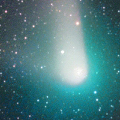
|
It brightened up to 8 mag from 2022 summer to 2023 spring. Now it is 17.2 mag (Oct. 19, ATLAS-HKO, Haleakala). It stays 18 mag for a while. In the Northern Hemisphere, it stays observable in good condition. It locates somewhat low in the Southern Hemisphere.
Date(TT) R.A. (2000) Decl. Delta r Elong. m1 Best Time(A, h)
Nov. 1 6 14.65 29 23.1 9.266 9.869 125 17.4 3:25 (182, 26)
Nov. 8 6 12.39 29 35.9 9.222 9.918 132 17.4 3:05 (180, 25)
|
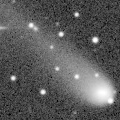
|
Now it is 17.2 mag (Oct. 26, Andrew Pearce). It stays 18 mag for a while. It stays extremely low in the Northern Hemisphere. In the Southern Hemisphere, it stays observable in good condition.
Date(TT) R.A. (2000) Decl. Delta r Elong. m1 Best Time(A, h)
Nov. 1 5 39.63 -46 31.5 8.154 8.466 105 17.4 2:59 ( 0, 79)
Nov. 8 5 34.24 -47 0.9 8.171 8.511 106 17.5 2:26 ( 0, 78)
|

|
It continues brightening even after the perihelion passage. Now it is 17.2 mag (Oct. 23, ATLAS Chile). It stays 18 mag for a while. In the Northern Hemisphere, it will never be observable after this. In the Southern Hemisphere, it stays observable in good condition.
Date(TT) R.A. (2000) Decl. Delta r Elong. m1 Best Time(A, h)
Nov. 1 0 8.79 -67 30.9 5.603 5.767 94 17.5 21:24 ( 0, 58)
Nov. 8 23 54.25 -66 35.5 5.696 5.793 90 17.6 20:43 ( 0, 59)
|

|
Now it is 17.7 mag (June 26, ATLAS Chile). It stays 17 mag for a while. It stays observable in good condition.
Date(TT) R.A. (2000) Decl. Delta r Elong. m1 Best Time(A, h)
Nov. 1 9 24.88 -5 58.0 3.964 3.810 73 17.6 3:25 (250, 36)
Nov. 8 9 24.84 -5 25.0 3.860 3.826 80 17.6 3:16 (245, 39)
|

|
Now it is 17.4 mag (Oct. 18, ATLAS South Africa). Fading slowly. It will be fainter than 18 mag in December. It will be getting lower gradually.
Date(TT) R.A. (2000) Decl. Delta r Elong. m1 Best Time(A, h)
Nov. 1 19 59.45 -13 43.9 5.272 5.205 80 17.6 20:02 (109, 47)
Nov. 8 20 3.47 -13 24.0 5.405 5.234 74 17.7 20:12 (103, 40)
|

|
Fading slowly. It will be fainter than 18 mag in December. In the Northern Hemisphere, it stays observable in good condition. It locates somewhat low in the Southern Hemisphere.
Date(TT) R.A. (2000) Decl. Delta r Elong. m1 Best Time(A, h)
Nov. 1 2 42.10 41 30.1 1.434 2.360 152 17.6 0:04 (180, 13)
Nov. 8 2 23.35 39 60.0 1.434 2.372 155 17.6 23:11 (180, 15)
|
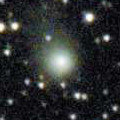
|
It brightened up to 12.1 mag in 2023 spring (May 20, 2023, Jose Guilherme de S. Aguiar). Now it is 17.4 mag (Mar. 25, ATLAS South Africa). It stays 18 mag for a while. It stays observable in good condition.
Date(TT) R.A. (2000) Decl. Delta r Elong. m1 Best Time(A, h)
Nov. 1 6 37.80 -20 15.0 7.939 8.312 108 17.7 3:25 (208, 74)
Nov. 8 6 35.56 -20 27.0 7.908 8.359 113 17.7 3:16 (191, 75)
|
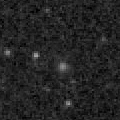
|
It is expected to brighten up to 7 mag in 2026 April. Now it is 18.4 mag (Oct. 27, Catalina Sky Survey). It will brighten rapidly after this. It will be unobservable in February in the Northern Hemisphere, or in December in the Southern Hemisphere. At the high light, it is observable in the low sky before the perihelion passage in the Northern Hemisphere, or after the perihelion in the Southern Hemisphere.
Date(TT) R.A. (2000) Decl. Delta r Elong. m1 Best Time(A, h)
Nov. 1 23 31.42 35 35.3 2.163 2.958 135 17.9 20:47 (180, 19)
Nov. 8 23 14.83 33 47.9 2.143 2.867 128 17.7 20:12 (178, 21)
|

|
Now it is 19.0 mag (Oct. 28, ATLAS South Africa). It stays 18 mag for a while. It stays observable in good condition.
Date(TT) R.A. (2000) Decl. Delta r Elong. m1 Best Time(A, h)
Nov. 1 8 4.11 -12 26.6 4.066 4.214 91 17.8 3:25 (237, 55)
Nov. 8 8 5.99 -13 11.5 3.988 4.224 96 17.7 3:16 (233, 58)
|

|
Now it is 18.4 mag (Oct. 21, ATLAS Chile). It stays 18 mag for a while. It stays observable in good condition.
Date(TT) R.A. (2000) Decl. Delta r Elong. m1 Best Time(A, h)
Nov. 1 7 10.32 7 26.2 3.717 4.158 109 17.8 3:25 (203, 45)
Nov. 8 7 10.68 6 55.3 3.635 4.168 116 17.8 3:16 (197, 47)
|
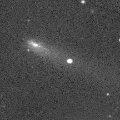
|
Now it is 16.3 mag (Oct. 26, Andrew Pearce). Fading slowly. It will be fainter than 18 mag soon. It stays observable in good condition.
Date(TT) R.A. (2000) Decl. Delta r Elong. m1 Best Time(A, h)
Nov. 1 3 45.82 2 46.9 1.749 2.690 156 17.8 1:06 (180, 52)
Nov. 8 3 39.70 2 36.5 1.761 2.720 161 17.9 0:33 (180, 52)
|

|
Now it is 17.9 mag (Oct. 3, ATLAS-MLO, Mauna Loa). It stays 18 mag for a while. In the Northern Hemisphere, it will be getting lower gradually. In the Southern Hemisphere, it will never be observable after this.
Date(TT) R.A. (2000) Decl. Delta r Elong. m1 Best Time(A, h)
Nov. 1 17 0.26 38 29.5 5.607 5.251 64 17.9 20:02 (124,-18)
Nov. 8 17 5.74 37 7.8 5.656 5.267 62 17.9 20:12 (120,-23)
|

|
It brightened up to 14.7 mag in spring (Apr. 7, Taras Prystavski). It stays 18 mag for a while. It will be getting higher gradually.
Date(TT) R.A. (2000) Decl. Delta r Elong. m1 Best Time(A, h)
Nov. 1 11 23.44 -1 0.6 4.691 4.074 46 17.9 3:25 (265, 9)
Nov. 8 11 23.38 -0 53.9 4.617 4.108 53 17.9 3:16 (262, 13)
|
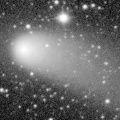
|
It brightened up to 9.6 mag from February to March in 2024 (Feb. 25, 2024, Thomas Lehmann). Now it is 17.9 mag (Sept. 17, Ken-ichi Kadota). Fading slowly. It will be fainter than 18 mag soon. In the Northern Hemisphere, it stays observable in good condition. It stays extremely low in the Southern Hemisphere.
Date(TT) R.A. (2000) Decl. Delta r Elong. m1 Best Time(A, h)
Nov. 1 22 49.70 38 13.6 6.320 6.965 127 17.9 20:06 (180, 17)
Nov. 8 22 48.82 37 20.0 6.435 7.023 122 18.0 20:12 (173, 17)
|
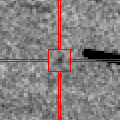
|
Now it is 18.3 mag (Oct. 16, E. Cortes, B. Lutkenhoner). Brightening slowly. In the Northern Hemisphere, it stays observable in good condition. In the Southern Hemisphere, it will be getting lower gradually after this, and it will be unobservable in January. It will brighten up to 15.5 mag in spring. But it is not observable around the perihelion passage.
Date(TT) R.A. (2000) Decl. Delta r Elong. m1 Best Time(A, h)
Nov. 1 20 56.36 -18 23.5 2.192 2.451 92 18.0 20:02 (118, 61)
Nov. 8 21 1.73 -17 31.2 2.240 2.407 87 17.9 20:12 (110, 54)
|

|
Now it is 17.2 mag (Oct. 23, ATLAS Chile). It stays 18 mag for a while. In the Northern Hemisphere, it will never be observable after this. In the Southern Hemisphere, it stays observable in good condition.
Date(TT) R.A. (2000) Decl. Delta r Elong. m1 Best Time(A, h)
Nov. 1 20 21.96 -58 11.2 2.924 2.878 77 17.9 20:02 ( 34, 57)
Nov. 8 20 25.68 -58 35.0 3.003 2.867 72 18.0 20:12 ( 37, 53)
|
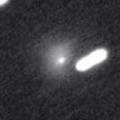
|
It brightened in major outburst of 5 mag. Now it is 17.8 mag (Oct. 14, E. Cortes, B. Lutkenhoner). It stays 18 mag for a while. It will be getting lower gradually.
Date(TT) R.A. (2000) Decl. Delta r Elong. m1 Best Time(A, h)
Nov. 1 19 46.57 -3 26.5 15.157 15.016 80 18.1 20:02 (117, 38)
Nov. 8 19 47.54 -3 30.2 15.281 15.030 73 18.1 20:12 (110, 31)
|
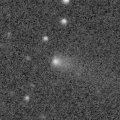
|
Now it is 17.5 mag (Oct. 22, ATLAS South Africa). Fading gradually. It stays observable in good condition.
Date(TT) R.A. (2000) Decl. Delta r Elong. m1 Best Time(A, h)
Nov. 1 0 7.97 2 18.2 1.823 2.692 144 18.4 21:25 (180, 53)
Nov. 8 0 6.98 2 3.2 1.904 2.714 136 18.6 20:56 (180, 53)
|

|
It had been lost for 113 years. It will pass the perihelion on Dec. 4. It brightened up to 18 mag in outburst in 2007. Brightening slowly. In the Northern Hemisphere, it stays observable in good condition. In the Southern Hemisphere, it will be getting higher gradually.
Date(TT) R.A. (2000) Decl. Delta r Elong. m1 Best Time(A, h)
Nov. 1 9 56.42 16 53.7 1.580 1.603 73 22.5 3:25 (237, 15)
Nov. 8 10 16.46 15 12.6 1.523 1.588 75 22.4 3:16 (238, 16)
|
|
![]()
 C/2023 RS61 ( PanSTARRS )
C/2023 RS61 ( PanSTARRS ) C/2025 J1 ( Borisov )
C/2025 J1 ( Borisov ) C/2019 E3 ( ATLAS )
C/2019 E3 ( ATLAS ) 195P/Hill
195P/Hill C/2025 R1 ( ATLAS )
C/2025 R1 ( ATLAS ) C/2020 V2 ( ZTF )
C/2020 V2 ( ZTF ) C/2017 K2 ( PanSTARRS )
C/2017 K2 ( PanSTARRS ) C/2019 U5 ( PanSTARRS )
C/2019 U5 ( PanSTARRS ) C/2023 U1 ( Fuls )
C/2023 U1 ( Fuls ) C/2024 X2 ( ATLAS )
C/2024 X2 ( ATLAS ) C/2023 H1 ( PanSTARRS )
C/2023 H1 ( PanSTARRS ) (3200) Phaethon
(3200) Phaethon C/2020 K1 ( PanSTARRS )
C/2020 K1 ( PanSTARRS ) C/2025 R3 ( PanSTARRS )
C/2025 R3 ( PanSTARRS ) 242P/Spahr
242P/Spahr 276P/Vorobjov
276P/Vorobjov 48P/Johnson
48P/Johnson C/2024 N3 ( Sarneczky )
C/2024 N3 ( Sarneczky ) C/2024 L5 ( ATLAS )
C/2024 L5 ( ATLAS ) C/2021 S3 ( PanSTARRS )
C/2021 S3 ( PanSTARRS ) 93P/Lovas 1
93P/Lovas 1 C/2025 L2 ( MAPS )
C/2025 L2 ( MAPS ) C/2013 C2 ( Tenagra )
C/2013 C2 ( Tenagra ) 486P/2024 H1 ( Leonard )
486P/2024 H1 ( Leonard ) 489P/Denning
489P/Denning![]()






























































